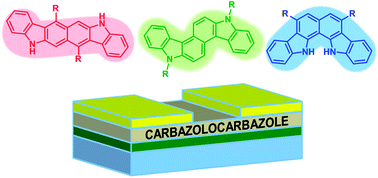Isomeric carbazolocarbazoles: synthesis, characterization and comparative study in Organic Field Effect Transistors†
Abstract
We report here the synthesis and characterization of a new family of isomeric carbazolocarbazole derivatives, namely

* Corresponding authors
a
Department of Organic Chemistry, Faculty of Chemistry, University of Murcia, Campus of Espinardo, 30100 Murcia, Spain
E-mail:
davidcc@um.es
Fax: +34 968364149
Tel: +34 868888389
b
Department of Chemistry, Northwestern University, 2145 Sheridan Road, Evanston, Illinois 60208, USA
E-mail:
a-facchetti@northwestern.edu, t-marks@northwestern.edu
c Departamento de Química-Física, Facultad de Ciencias, Campus de Teatinos 29071, Málaga, Spain
d Laboratory of Chemistry, Molecular Engineering of Angers (CIMA), UMR CNRS 6200 – University of Angers, 2, Boulevard Lavoisier, 49045 Angers cedex, France
We report here the synthesis and characterization of a new family of isomeric carbazolocarbazole derivatives, namely

 Please wait while we load your content...
Something went wrong. Try again?
Please wait while we load your content...
Something went wrong. Try again?
M. Más-Montoya, R. P. Ortiz, D. Curiel, A. Espinosa, M. Allain, A. Facchetti and T. J. Marks, J. Mater. Chem. C, 2013, 1, 1959 DOI: 10.1039/C2TC00363E
To request permission to reproduce material from this article, please go to the Copyright Clearance Center request page.
If you are an author contributing to an RSC publication, you do not need to request permission provided correct acknowledgement is given.
If you are the author of this article, you do not need to request permission to reproduce figures and diagrams provided correct acknowledgement is given. If you want to reproduce the whole article in a third-party publication (excluding your thesis/dissertation for which permission is not required) please go to the Copyright Clearance Center request page.
Read more about how to correctly acknowledge RSC content.
 Fetching data from CrossRef.
Fetching data from CrossRef.
This may take some time to load.
Loading related content
